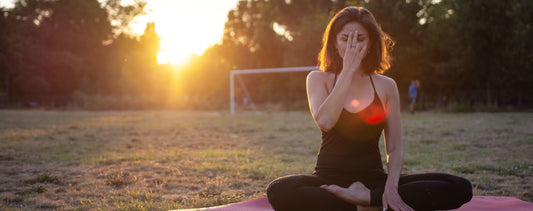There are certain things you may have come to expect from your yoga classes, like whether or not you’ll break a sweat or the fact that you will always end with Savasana. There are also some cues (or directions) you can usually expect to hear from your teachers, but aren’t actually clear on what they mean. Here are five common phrases heard in yoga class, and what they really are saying for you and your practice.
Why your teacher said it: There are many benefits to conscious breathing. In the early moments of your yoga class though, connecting to the way you breathe helps to quiet the mind and transitions you from your day “out there” to the moment “in here." The nervous system calms down when you slow down the breath, taking you out of the stressful fight-or-flight mode.
Also, when you consciously breathe, you are able to better connect to mindful movement, both on and off the mat. Remember, it is the connection to breath and sensation that makes a physical yoga practice different than other forms of exercise.
Why your teacher said it: As author and motivational speaker Wayne Dyer said, “Our intention creates our reality.” In yoga, it is your intention that makes the experience a mindful one. Without intention, your mind will likely wander, and you’ll miss out on the spiritual and energetic benefits that are part of the foundation of a yoga practice. How you direct your thoughts and shift your vibration are actually more important in the grand scheme of things than if you’re able to simply stand on your head.
Why your teacher said it: This is a common cue because following it is one of the best ways you can protect yourself from long-term injury. Bones and muscles are stronger than joints are, so when you are geometrically aware of how your bones are lined up, gravity prevents the weight and pressure from going to the more delicate joints. You’ll feel more stable when your joints are stacked vertically, and this will help you feel strong, successful, and safe in your poses.
Why your teacher said it: You will be amazed at how core stability and awareness can transform your balance and power … not to mention your body. By engaging your abdominal muscles, you are not only getting a stronger center, but you are protecting and strengthening the spine and back muscles. Since low back pain is one of the most common complaints from yoga students (and human beings in general), toning these muscles is certainly a worthwhile endeavor for overall well-being.
While this one may seem easy, it actually takes some practice to learn to distinguish the different sensations you might be experiencing. For example, can you tell the difference between discomfort and pain? Going too far into your flexibility, versus just far enough? Or how about healthy fatigue versus over-exhaustion? Learning to listen to your body will help you flourish, heal, and live a long and vibrant life, both on and off your mat.
Why your teacher said it: When your teacher tells you to listen to your body, he or she wants you to be in charge of your own practice, keep yourself safe, and empower yourself to get what you need out of your yoga session. What your teacher actually is saying is that it is more important to listen to your own intuition than to listen to what the teacher is telling you to do. Since all bodies are different, and we each have our own batch of strengths and limitations, it’s important that you acknowledge that a yoga practice is a personal one. It is a time to listen to your own inner wisdom, rather than conform to external expectations.
Find balance anywhere, anytime with the new Chopra App. Download it now for hundreds of personalized guided meditations at your fingertips.
*Editor’s Note: The information in this article is intended for your educational use only and is not a substitute for professional medical advice, diagnosis, or treatment. Always seek the advice of your physician or other qualified health providers with any questions you may have regarding a medical condition and before undertaking any diet, supplement, fitness, or other health programs.
1. The Cue: “Breathe”
What it means: Obviously you don’t need to be reminded to actually breathe, so when you hear this cue, your teacher wants you to actually pay attention to your breath. Sometimes, the message is simply to notice your breathing—how the air feels coming in and out of your nose, the rhythm of the rise and fall of your belly, or approximately how much of your lung capacity you are engaging. Other times, the cue is meant for you to actually change your breath—usually to simply slow it down and deepen it.Why your teacher said it: There are many benefits to conscious breathing. In the early moments of your yoga class though, connecting to the way you breathe helps to quiet the mind and transitions you from your day “out there” to the moment “in here." The nervous system calms down when you slow down the breath, taking you out of the stressful fight-or-flight mode.
Also, when you consciously breathe, you are able to better connect to mindful movement, both on and off the mat. Remember, it is the connection to breath and sensation that makes a physical yoga practice different than other forms of exercise.
2. The Cue: “Set an Intention for Your Practice”
What it means: Sometimes your teacher presents the class with a collective intention, but other times, he or she might just encourage you to set your own. If you’ve ever been stumped on what to do when your teacher says to set an intention, allow it to be simple rather than pressure yourself for it to be particularly unique or creative. Simple intentions like, “May I be strong and steady,” “May I stay connected to my breath,” or “May I release my anger toward so-and-so” are usually the most powerful and transformative.Why your teacher said it: As author and motivational speaker Wayne Dyer said, “Our intention creates our reality.” In yoga, it is your intention that makes the experience a mindful one. Without intention, your mind will likely wander, and you’ll miss out on the spiritual and energetic benefits that are part of the foundation of a yoga practice. How you direct your thoughts and shift your vibration are actually more important in the grand scheme of things than if you’re able to simply stand on your head.
3. The Cue: “Stack Your Bones” or “Stack Your Joints”
What it means: This alignment cue refers to the spatial relationship between your body parts in order to keep you safe. When in an arm balance for example (like Plank Pose), this cue refers to stacking (or lining up) your shoulders directly over your wrists. In a pose like Forward Fold, you’ll want to bring your hips vertical of your knees, not behind them. And in lunge poses, like Crescent Lunge or Warrior II, the cue will be referring to the knee joint being above the ankle joint, not in front of it.Why your teacher said it: This is a common cue because following it is one of the best ways you can protect yourself from long-term injury. Bones and muscles are stronger than joints are, so when you are geometrically aware of how your bones are lined up, gravity prevents the weight and pressure from going to the more delicate joints. You’ll feel more stable when your joints are stacked vertically, and this will help you feel strong, successful, and safe in your poses.
4. The Cue: “Engage Your Core”
What it means: This cue asks you to tighten and stabilize your abdominal muscles. In a good yoga class, you are using your core muscles to help you find your center in every pose, not just when you’re doing crunches or yogi bicycles. “Engage your core” literally means that you should bring awareness to your midsection, and tighten your abdominal muscles. When given in the context of how you move from pose to pose, it means that you should initiate the movement from a strong center, rather than letting momentum move your limbs.Why your teacher said it: You will be amazed at how core stability and awareness can transform your balance and power … not to mention your body. By engaging your abdominal muscles, you are not only getting a stronger center, but you are protecting and strengthening the spine and back muscles. Since low back pain is one of the most common complaints from yoga students (and human beings in general), toning these muscles is certainly a worthwhile endeavor for overall well-being.
5. The Cue: “Listen to Your Body”
What it means: This cue is a reminder to stay connected to the physical and energetic sensations in your body at any given moment. When you “listen to your body,” you honor and respect when you’ve gone too far and when you are capable of more than you give yourself credit for.While this one may seem easy, it actually takes some practice to learn to distinguish the different sensations you might be experiencing. For example, can you tell the difference between discomfort and pain? Going too far into your flexibility, versus just far enough? Or how about healthy fatigue versus over-exhaustion? Learning to listen to your body will help you flourish, heal, and live a long and vibrant life, both on and off your mat.
Why your teacher said it: When your teacher tells you to listen to your body, he or she wants you to be in charge of your own practice, keep yourself safe, and empower yourself to get what you need out of your yoga session. What your teacher actually is saying is that it is more important to listen to your own intuition than to listen to what the teacher is telling you to do. Since all bodies are different, and we each have our own batch of strengths and limitations, it’s important that you acknowledge that a yoga practice is a personal one. It is a time to listen to your own inner wisdom, rather than conform to external expectations.
Find balance anywhere, anytime with the new Chopra App. Download it now for hundreds of personalized guided meditations at your fingertips.
*Editor’s Note: The information in this article is intended for your educational use only and is not a substitute for professional medical advice, diagnosis, or treatment. Always seek the advice of your physician or other qualified health providers with any questions you may have regarding a medical condition and before undertaking any diet, supplement, fitness, or other health programs.






















